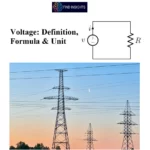
Electric current is the time rate of change of charge, measured in amperes (A). Let’s see the Formula for Electrical Current and also Electrical Current Definition with its SI Unit.
Electrical Current Definition
The constant flow of charged particles in a circuit is called an electric current. Electric current is the flow of electric charge. When the ends of an electric conductor are at different electric potentials, charge flows from one end to the other. Thus, the constant flow of charged particles in a circuit is called an electrical current.

Formula for Electric Current
The current is the rate of flow of charge through a surface area placed perpendicular to the direction of flow. If charge Δq flows in time Δt, the Formula for Electrical Current (Average) is defined as
I av = ΔQ /Δt
where ΔQ is the amount of charge passing through a given area in time Δt .
If the rate of flow of charge varies with time, the current also varies with time. The instantaneous current is expressed as : I = dq/dt
The electric current through a conductor is the rate of transfer of charge across a surface placed normal to the direction of flow.
Electric Current SI Unit:
The SI unit of current is ampere. Its symbol is A
1 ampere = 1 coulomb/1 second

Formula for Electrical Current by Ohm’s Law
In 1828, Ohm studied the relation between current in a conductor and potential difference applied across it. He expressed this relation in the form of a law, known as Ohm’s law. According to Ohm’s law, the electric current through a conductor is directly proportional to the potential difference across it, provided the physical conditions such as temperature and pressure remain unchanged.

Let V be the potential difference applied across a conductor and I be the current flowing through it.
According to Ohm’s law, Electrical current formula can be derived from below equation.
V ∝ I or V = RI ⇒ V I = R
Thus, Formula for Electrical Current is I = V/R
LIKE WHAT YOU’RE READING?
CHECK OUT SOME OF OUR OTHER GREAT CONTENT HERE:
- WORKING OF AN INDUCTOR – EXPLAINED
- STEP UP TRANSFORMER: DEFINITION, CONSTRUCTION, WORKING & APPLICATIONS
- LIMITATIONS OF OHM’S LAW
- WHAT ARE THE USES OF CAPACITOR
- VARIOUS USES OF A RESISTOR
- DEFINITION FOR ELECTRICAL CIRCUIT
- DEFINITION & FORMULA OF POWER IN ELECTRICAL
- WHAT IS THE ZENER DIODE? – EXPLAINED
- CHARACTERISTICS OF A ZENER DIODE – EXPLAINED
- VOLTAGE REGULATION BY ZENER DIODE – EXPLAINED




21 Comments